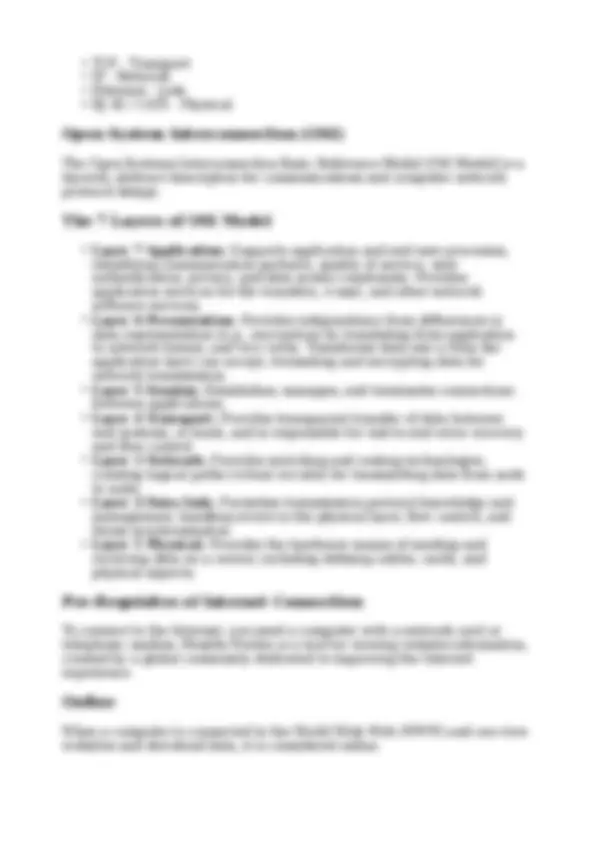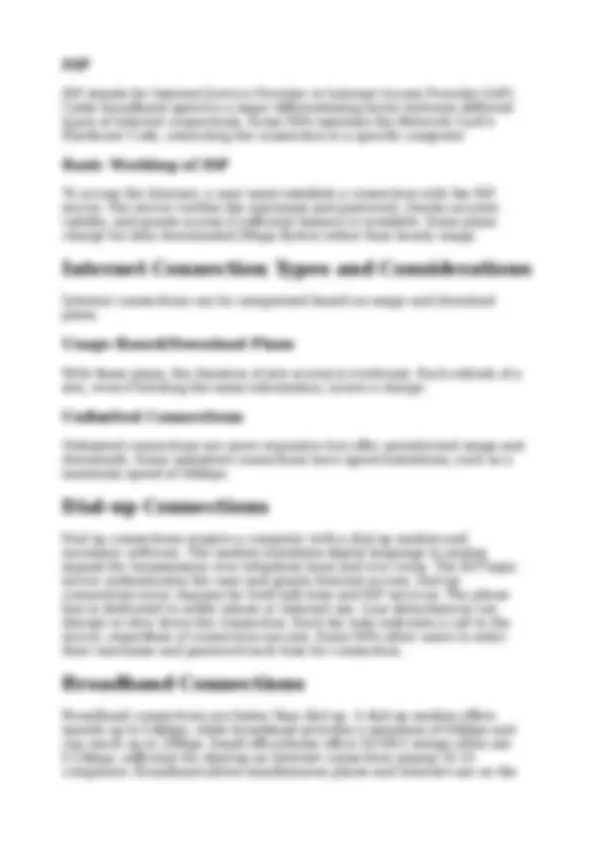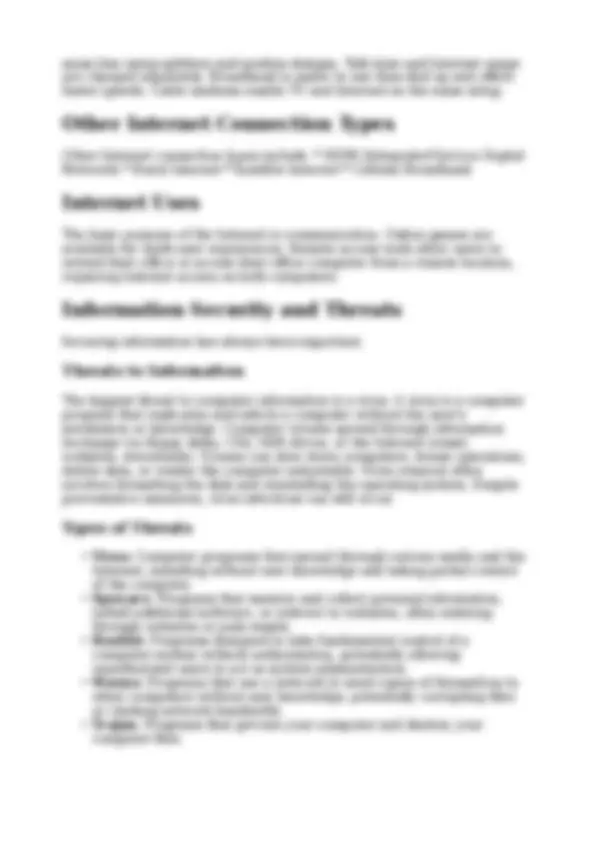





Study with the several resources on Docsity

Earn points by helping other students or get them with a premium plan


Prepare for your exams
Study with the several resources on Docsity

Earn points to download
Earn points by helping other students or get them with a premium plan
Community
Ask the community for help and clear up your study doubts
Discover the best universities in your country according to Docsity users
Free resources
Download our free guides on studying techniques, anxiety management strategies, and thesis advice from Docsity tutors
An overview of the cyber world, focusing on the internet, online resources, information security, and digital signatures. It explains the scope of computers in daily life, fundamental computer principles, and the basics of computer networks. It covers internet connection prerequisites, isp operations, dial-up and broadband connections, and various internet applications. The document also addresses information security, types of threats, prevention measures, and the use of digital signatures to secure documents in cyberspace. It is designed to provide a foundational understanding of computer networks and online security for students and professionals alike, offering insights into both the technical and practical aspects of navigating the digital world. Useful for those seeking to understand the basics of computer networking and security.
Typology: Summaries
1 / 6

This page cannot be seen from the preview
Don't miss anything!




This document provides an overview of the cyber world, focusing on the Internet, online resources, information security, and digital signatures.
Computers are ubiquitous in modern life, found in shopping centers, railway and airline reservations, microwave ovens, and phones. Transactions using debit or credit cards involve complex security measures to access bank account information.
The prefix 'e' has become common, transforming mail into e-mail, banking into e-banking, and commerce into e-commerce. Cyber, derived from cybernetics, describes the range of things available through computers. Examples include cyber-phobia and cyberspace. The term cyberspace encompasses humans, computers (hardware and software), and the capabilities of computers. Computers can be more reliable than humans for repetitive tasks. While manual banking offered a personal touch, computers provide consistent speed regardless of the customer. This connectivity extends to mobile phones.
A computer network enables communication and resource sharing (knowledge, hardware, software) between two or more computers. International phone calls illustrate how data travels through various networks, requiring adherence to rules for effective communication. In computer networking, standard rules, called protocols, must be followed for successful interaction.
A protocol is a standard that controls connection, communication, and data transfer between computing endpoints.
IP (Internet Protocol): A data-oriented protocol for communicating data across a packet-switched internetwork. UDP: Allows programs on networked computers to send short messages (datagrams) to each other.
TCP: Provides reliable, in-order delivery of a stream of bytes, suitable for file transfer and e-mail. DHCP (Dynamic Host Configuration Protocol): Used by networked devices to obtain IP addresses and other parameters from a DHCP server. FTP (File Transfer Protocol): Used to transfer data between computers over the Internet or a network. Telnet: A network protocol used on the Internet or local area network (LAN) connections. SSH (Secure Shell): A network protocol that allows data exchange over a secure channel between two computers, using encryption for confidentiality and integrity. POP3 (Post Office Protocol 3): Used by local e-mail clients to retrieve e-mail from a remote server. SMTP (Simple Mail Transfer Protocol): The standard for e-mail transmissions across the Internet.
Networks are classified by scale/scope:
PAN (Personal Area Network): A network for communication among devices close to one person. LAN (Local Area Network): A network covering a small geographic area, such as a home, office, or building. CAN (Campus Area Network): Limited to an area smaller than a typical MAN. MAN (Metropolitan Area Network): A network connecting two or more LANs or CANs within a town, city, or metropolitan area. WAN (Wide Area Network): A network covering a broad geographic area, often using facilities provided by telephone companies.
Intranet: Uses Internet protocols and IP-based tools, controlled by a single administrative entity. Extranet: An Intranet with limited connections to other networks. Internet: A worldwide, publicly accessible series of interconnected computer networks transmitting data via packet switching using the Internet Protocol (IP).
The Internet protocol suite is the set of communications protocols that implement the protocol stack on which the Internet and most commercial networks run. It can be viewed as a set of layers, each solving problems related to data transmission and providing services to upper layers. Upper layers are closer to the user and deal with abstract data, relying on lower layers for physical transmission.
HTTP - Application
ISP stands for Internet Service Provider or Internet Access Provider (IAP). Cable broadband speed is a major differentiating factor between different types of Internet connections. Some ISPs maintain the Network Card’s Hardware Code, restricting the connection to a specific computer.
To access the Internet, a user must establish a connection with the ISP server. The server verifies the username and password, checks account validity, and grants access if sufficient balance is available. Some plans charge for data downloaded (Mega Bytes) rather than hourly usage.
Internet Connection Types and Considerations
Internet connections can be categorized based on usage and download plans.
With these plans, the duration of site access is irrelevant. Each refresh of a site, even if fetching the same information, incurs a charge.
Unlimited connections are more expensive but offer unrestricted usage and downloads. Some unlimited connections have speed limitations, such as a maximum speed of 64kbps.
Dial-up Connections
Dial-up connections require a computer with a dial-up modem and necessary software. The modem translates digital language to analog signals for transmission over telephone lines and vice versa. The ISP login server authenticates the user and grants Internet access. Dial-up connections incur charges for both talk time and ISP services. The phone line is dedicated to either phone or Internet use. Line disturbances can disrupt or slow down the connection. Each fax tone indicates a call to the server, regardless of connection success. Some ISPs allow users to enter their username and password each time for connection.
Broadband Connections
Broadband connections are faster than dial-up. A dial-up modem offers speeds up to 54kbps, while broadband provides a minimum of 64kbps and can reach up to 2Mbps. Small office/home office (SOHO) setups often use 512kbps, sufficient for sharing an Internet connection among 10- computers. Broadband allows simultaneous phone and Internet use on the
same line using splitters and modem designs. Talk time and Internet usage are charged separately. Broadband is easier to use than dial-up and offers faster speeds. Cable modems enable TV and Internet on the same setup.
Other Internet Connection Types
Other Internet connection types include: * ISDN (Integrated Service Digital Network) * Rural Internet * Satellite Internet * Cellular Broadband
Internet Uses
The basic purpose of the Internet is communication. Online games are available for multi-user experiences. Remote access tools allow users to extend their office or access their office computer from a remote location, requiring Internet access on both computers.
Information Security and Threats
Securing information has always been important.
The biggest threat to computer information is a virus. A virus is a computer program that replicates and infects a computer without the user's permission or knowledge. Computer viruses spread through information exchange via floppy disks, CDs, USB drives, or the Internet (email, websites, downloads). Viruses can slow down computers, freeze operations, delete data, or render the computer unbootable. Virus removal often involves formatting the disk and reinstalling the operating system. Despite preventative measures, virus infections can still occur.
Virus: Computer programs that spread through various media and the Internet, installing without user knowledge and taking partial control of the computer. Spyware: Programs that monitor and collect personal information, install additional software, or redirect to websites, often entering through websites or junk emails. Rootkit: Programs designed to take fundamental control of a computer system without authorization, potentially allowing unauthorized users to act as system administrators. Worms: Programs that use a network to send copies of themselves to other computers without user knowledge, potentially corrupting files or choking network bandwidth. Trojan: Programs that get into your computer and destroy your computer files.